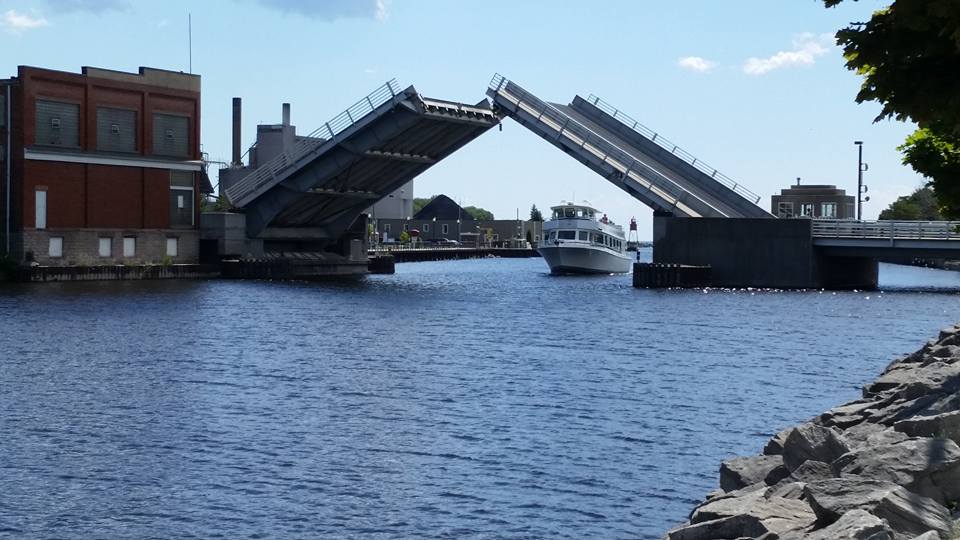In 1862, before Alpena’s first bridge was built across the Thunder Bay River, a ferry boat was the only means of travel between the north and south sections of this rapidly growing Northeast Michigan town.

Construction of Alpena’s first 2nd Avenue bridge in 1865.
The ferry was a 30 ft. long flat bottom scow that had a long iron pole extending up from the bottom with a ring attached to the top. A rope was attached to the ring and connected to sturdy poles on each side of the river. Passengers desiring to get across the river would have to get on the docked ferry and then pull their way across by hanging onto and pulling along the rope.
Something needed to be done to make crossing the river more efficient. During the spring election of 1864, it was voted to raise $1,000 by tax for the purpose of building a bridge across the Thunder Bay River.

2nd Avenue Wooden Swing Bridge in 1873.
The new, cheaply constructed bridge worked for a while, but within a few years, the bridge began to deteriorate. By 1869 it was in very poor shape. An effort was made for a new bridge, but a decision could not be reached. Once again a floating device that was a sort of compromise between a scow and a raft was stretched across the river. The citizens were not happy with the makeshift solution.
In 1872, the city council took the matter in hand and a new center-pivoting wooden swinging bridge was built by Mr. Samuel L. Boggs at the cost of nearly $7,000. It was completed by the spring of 1873.

Construction of the Steel Bridge in 1886.
Thirteen years later in 1886, the wooden swing bridge was replaced by a fine steel swing bridge that had an impressive overhead superstructure.
The Smith Bridge Company of Ohio was contracted to erect it for $8,260. Work commenced on March 1, and on April 9th the first team of horses crossed. The bridge was 174 ft long with a 20-ft wide roadway. There were two foot passages, each 6 ft wide. The bridge pivoted on a center pier to permit passage of the many ships entering and leaving the Thunder Bay River to Lake Huron. In the beginning, the bridge was turned by manpower. Later by a motorized turnkey. Christian Lund, a city employee, was the operator of the Second Avenue Bridge for 19 years. There were days when he turned the bridge as many as 30 times.

Temporary floating bridge in 1919.
In 1918, the steel swing bridge was in desperate need of repair, and a temporary floating pedestrian bridge was constructed across the Thunder Bay River until the repairs were complete.
By the 1930’s, the steel Second Avenue Swing Bridge had become inadequate and occasionally inoperative. A new bridge was again needed. In 1936, another ferry was put to use to help aid in crossing the river, this time with a gasoline engine. It was a novelty operation, and people were taking the short ride just for the experience.

Floating bridge in 1938.
On August 20, 1938, the Public Works Administration approved the city’s application for federal funds to help finance construction of a new second avenue bridge. This was an outright grant of $157,909 to supplement approximately $190,250, which the Municipal Council desired to raise through a bond issue to be voted upon August 29, 1938. That special election resulted in approval of a $192,500 bond issue for the new Second Avenue Bridge.
During the construction, another temporary pedestrian bridge was constructed of wood and floated on 55-gallon drums. It stretched across the river from late August 1938 to December of 1939, with lights strung on posts to provide light for travelers after dark.

Second Avenue Bridge today, photo courtesy Photic Zone
On December 1, 1939, the new bridge opened to pedestrian traffic. It opened to vehicular traffic on December 6, 1939. The beautiful and unusual construction of this bridge earned it a winning award from the American Institute of Steel Construction in 1939. This is the bridge that we still use today, which had an extensive repair in 1988, and recently underwent another extensive repair beginning in late 2016 through spring of 2017. We think it’s just beautiful!
Sources: Haltiner, Robert. The Town That Wouldn’t Die, Alpena Gleanings and Stones from her Granite Gardens, The Town That Went to War.





 420 N. 2nd Ave. Alpena, MI 49707
420 N. 2nd Ave. Alpena, MI 49707 989-340-2288
989-340-2288 